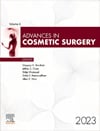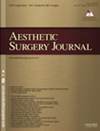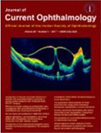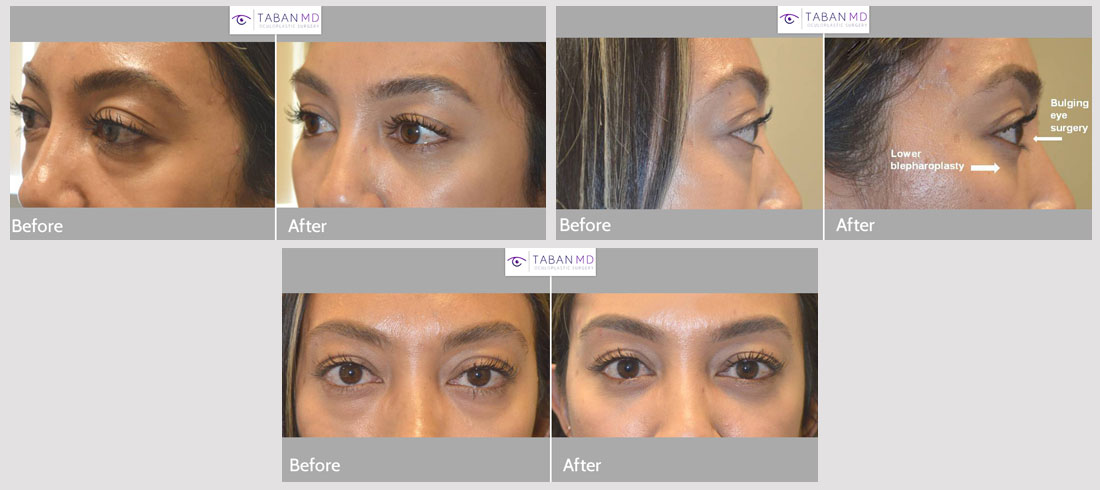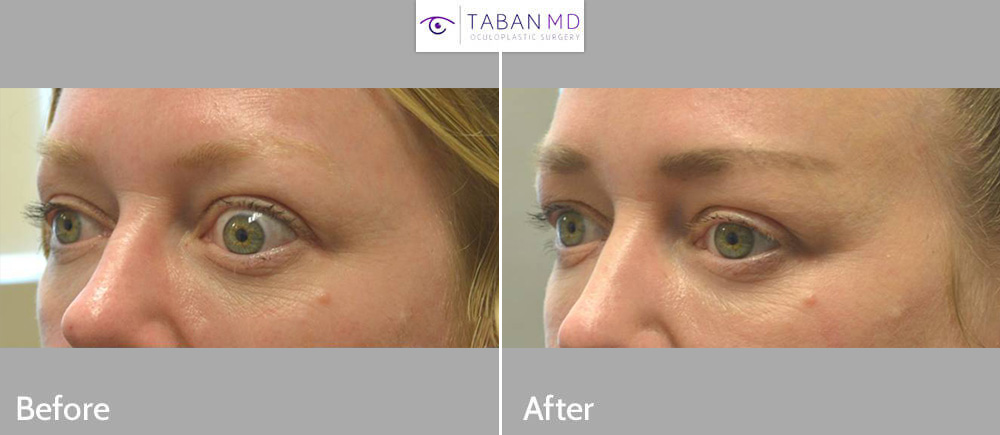Thyroid Eye Disease Surgery
What Is Grave’s Disease?
Thyroid orbitopathy (also known as thyroid eye disease or Graves’ eye disease) is an autoimmune inflammatory condition. It is related to the thyroid gland, which affects the different structures within the orbit (eye socket). It is also related to surrounding tissues including the eye muscles, orbital fat, and eyelids. The thyroid gland is also usually affected but the timing and severity of the thyroid gland disease and orbital disease can vary greatly. A small percentage of patients in Los Angeles may have eyelid and orbital manifestations of the disorder without developing a thyroid abnormality. For individuals who are suffering from bugling eyes due to thyroid orbitopathy, Dr. Taban performs orbital decompression surgery, a treatment that helps reduce the appearance of bulgy eyes by expanding the eye socket.
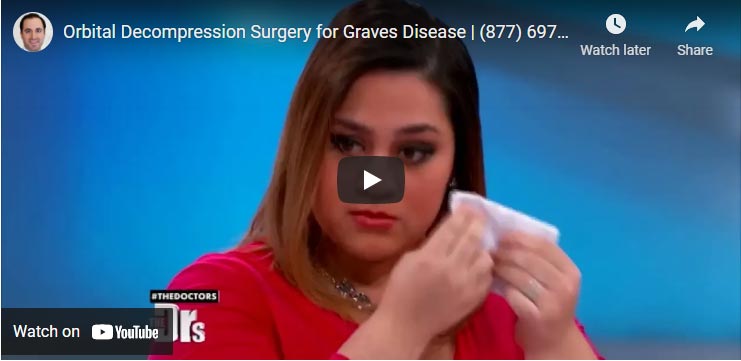
Symptoms Of Thyroid Eye Disease
As stated earlier, the eye/orbit involvement in Graves’ disease can range from very mild to very severe. The symptoms begin slowly but they can develop rapidly. The usual course of the eye disease is worsening over a year period, with subsequent “burning out.” It’s during the “burned out” stage that rehabilitative surgery (bulgy or bulging eye surgery through orbital decompression and blepharoplasty) in Los Angeles is usually performed.
Symptoms and signs also vary, depending on the severity of the disease. These include eye irritation/dryness, eye pressure, tearing, redness, eyelid swelling and retraction, bulgy or protruded eyes (proptosis), double vision (diplopia) and blurred or even loss of vision. The vision loss can be significant eye dryness or exposure (secondary to bulgy eyes – proptosis) and/or from optic nerve compression.
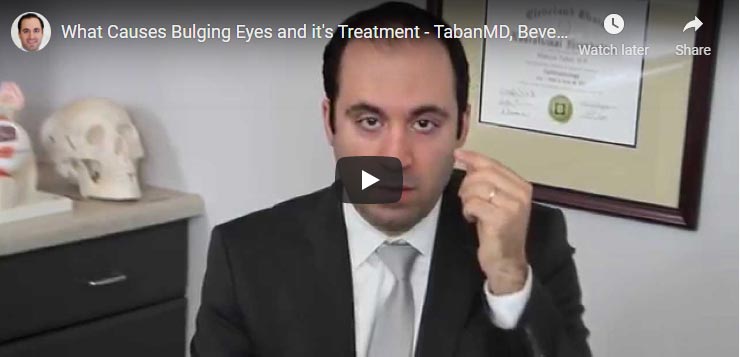
Treatment For Grave’s Disease
The treatment of a patient with Graves’ disease is multidisciplinary, with help of endocrinologist, thyroid surgeon, ophthalmologist, and oculoplastic surgeon. The underlying problem, which is the thyroid gland, needs to be treated, which may include medications, radioactive iodine, and/or thyroid surgery.
During the active inflammatory stage of Graves’ disease, the eye symptoms are treated conservatively, including aggressive eye lubrication and possibly systemic medication (steroids). Smoking has been shown to worsen the eye pathology and hence quitting is highly recommended. Frequent monitoring may be necessary, especially in severe cases with significant bulgy eyes and risk of optic nerve damage.
Read Dr. Taban’s Manuscript about Modified (Scarless) Orbital Decompression Technique.


Read Dr. Taban's manuscript about Expanding Role of Orbital Decompression in Aesthetic Surgery.


Read Dr. Taban's Manuscript about Combined Orbital Decompression and Eyelid Retraction Surgery.
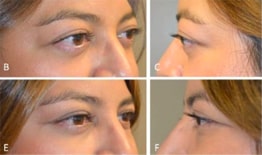
Orbital Decompression Surgery For Thyroid Eye Disorders
Once the inflammatory phase of the disease has subsided, patients with eyelid abnormalities, double-vision or proptosis may be eligible for surgical correction to improve their function and appearance. The first stage of therapy is usually orbital decompression surgery (bulgy eye surgery) to reduce proptosis (protruded bulgy eyes) by expanding the eye socket (orbit) to allow the eyeball to move back.
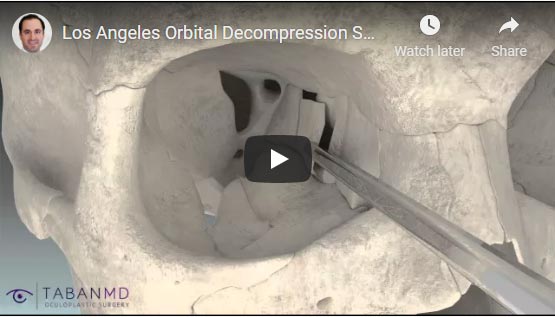
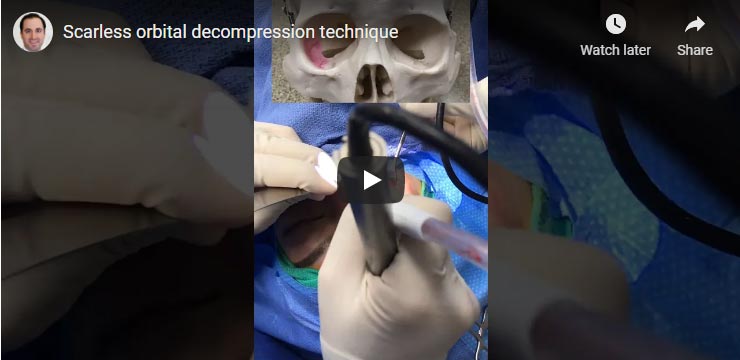
Surgical video demonstrating scarless orbital decompression.
Oculoplastic Surgeon Dr. Taban in Los Angeles uses the latest minimally invasive technique, through hidden incisions, to achieve the desired effect. By making the orbit larger internally, the eyeball can sit back more into a more natural state, reducing or eliminating the appearance of bulging eyes.This is an outpatient surgery procedure with about 7-10 days of postoperative swelling/bruising. Second stage surgery is for those with restrictive strabismus causing diplopia (double vision) not corrected by prism glasses. The third stage operation is eyelid surgery, both reconstructive and cosmetic. Eyelid retraction is a frequent abnormality of thyroid eye disease causing elevation of the upper eyelids, giving a “stared” look appearance. This can be corrected, along with bags around the eyes.
During your consultation with Dr. Taban in Beverly Hills or Los Angeles, he will evaluate your eyes and orbits to assess your specific anatomy and severity of Graves’ disease, including proptosis (bulgy eye) and eyelid retraction, and then discuss the different treatments necessary, including orbital decompression surgery (bulgy eye surgery), retraction surgery, and/or blepharoplasty. Sometimes, noninvasive surgery using injectable fillers can improve eye appearance, by improving retraction and/or hollowness around the eyes. The goal of the treatment is to restore natural youthfulness to the eyes and surrounding structures.
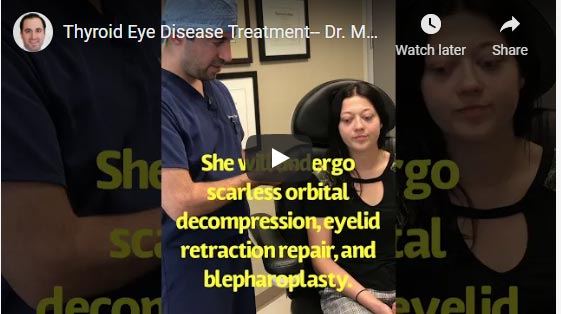
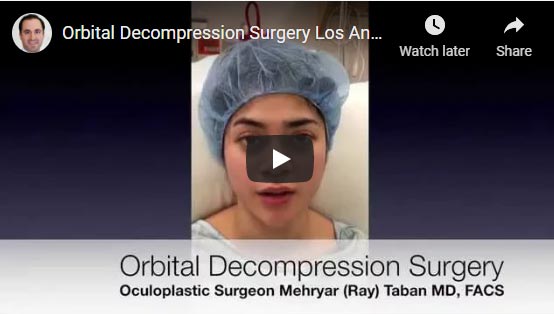
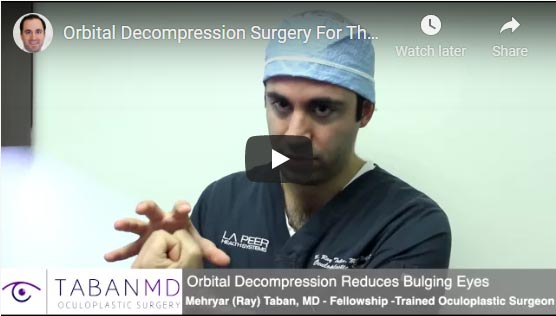
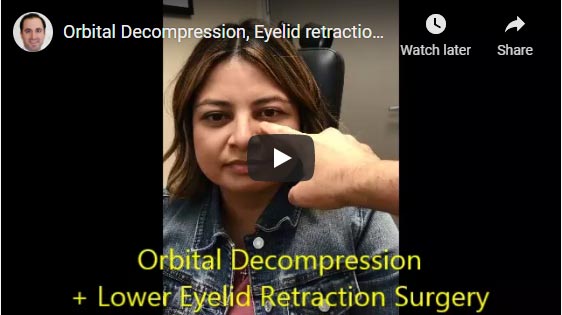
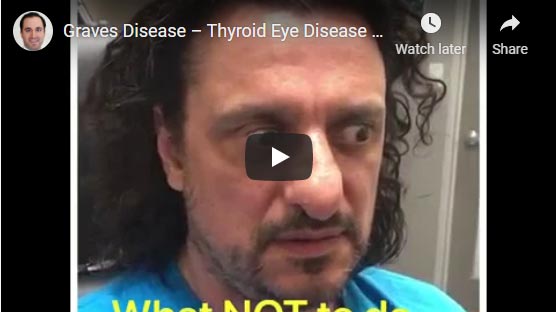
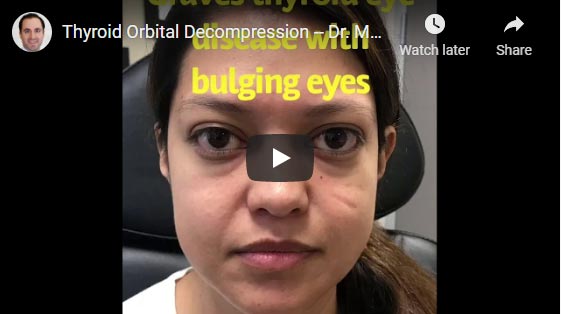
Before & After Real Patient Photos
Words cannot explain how much my life has changed since the life changing procedure/surgery. I had orbital decompression, lower eyelid retraction, and orbital rim tear trough implants…I’ve spent a great deal of time doing extensive research into this surgical procedure…After the consultation with Dr. Taban, I finally felt I found someone who I trusted … He exceeded my expectations with the outcome of the procedure…We only get one pair of eyes and I trusted Dr. Taban with my procedure and the results have changed my life physically and emotionally. Thank you, Dr.Taban.
Dr. Taban performed bilateral orbital decompression for my TED in August, 2016. It’s been more than 6 months since the surgery and my eyes have completely recovered and the scars from incisions were barely visible. I can say with confidence that he is THE best and the go-to doctor for this type of surgery. I was an out of town patient (thousands of miles away) … Dr. Taban is extremely talented, yet so humble … I can’t express my thankfulness enough to Dr. Taban and his staff … He is a gifted doctor …
Dr. Taban is a miracle doctor. I am 18 years old and had Graves Disease since my early teens. I saw him on The Doctors Show … He made me feel so comfortable (at consultation) … It has been two months since my surgery and the results are better than I expected. … my results seem unreal because I still can’t believe how the results turned out. Dr. Taban is such a humble person … I never thought I could get my eyes back but because of him I did. Dr. Taban really changed my life and I’ll be grateful forever.
Dr. Taban has been an amazing and one of a kind doctor. I suffered from graves disease and did extensive research trying to find a good doctor for my orbital decompression surgery… Dr. Taban really cares for his patients, before the surgery he makes you feel at ease and calm reassuring you that you’re in great hands… I’ve never had a doctor who shows you how much they care for your well being than doctor Taban… As to my results, I could not be any happier. My eyes look great, I feel like a whole new person and so many people have complimented my awesome results. I cannot thank doctor Taban enough. He works miracles …
Dr. Taban & Orbital Decompression Surgery Changed My Life! – When I first noticed my eyes changing because of my Graves Eye Disease (or Thyroid Eye Disease), I was so depressed. …
… Dr. Taban is incredibly professional and a bit of a savant in his field. He has the unique balance of compassion and professionalism, …Thank you for giving me my confidence back Dr. Taban!
I was diagnosed with Graves’ Disease in 2007 … I had 2 other surgeons prior to meeting Dr. Taban…. Dr. Taban did the orbital decompression on both of my eyes in 2010 and my eyelids retraction in 2011. … He made me look normal again. … I’m very grateful to Dr. Taban. He brought back my self-confidence.

